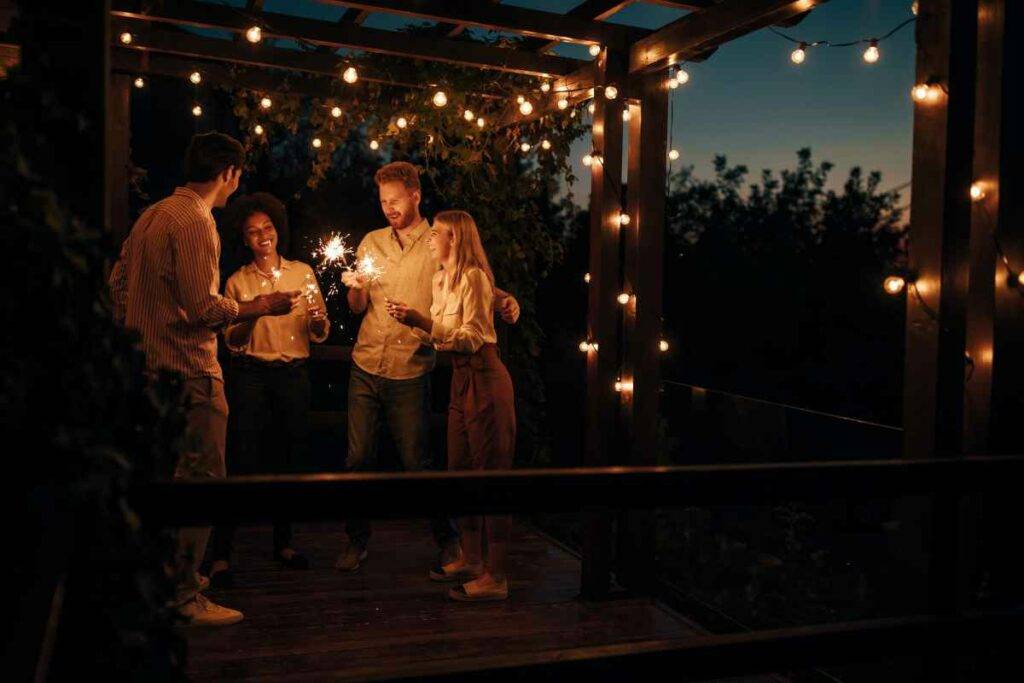Hello, friends! Wendy Blair here, your favorite homemaker and DIY enthusiast. If you’re like me, you love spending time outdoors, especially in your backyard or patio. One of my favorite ways to create a cozy and inviting atmosphere outside is with string lights. There’s something magical about their soft glow that makes any evening feel special. I recently took on the project of hanging outdoor string lights in my backyard, and let me tell you—it was quite the adventure!
How to Hang Outdoor String Lights
In this guide, I’ll walk you through how I did it, including the challenges I faced and the solutions I found. Let’s dive in!
The Vision for My Backyard
Before I started, I had a vision in mind: a warm, welcoming space where I could enjoy evenings with family and friends. I pictured string lights creating a soft glow, casting just enough light to see but not too much to ruin the ambiance. I wanted the lights to stretch across the yard, connecting from one side to the other, with a few strings overhead for that starry-sky effect. But how would I make it happen? Here’s what I did.
Planning the Layout
The first step was planning the layout. I needed to decide where I wanted the lights to go and how many strings I would need. My backyard has a large patio area with a couple of trees and a pergola, so I had some anchor points to work with. Here’s how I approached it:
- Measure the Distance: I used a measuring tape to determine the length of each section where I wanted the lights to hang. This helped me calculate how many strings I would need and how long each should be.
- Choose Anchor Points: I identified solid anchor points to attach the lights. For me, this included the pergola, a couple of sturdy trees, and the eaves of my house. If you don’t have trees or a pergola, you can use poles or install wall mounts.
- Consider Power Sources: I needed to think about where to plug in the lights. I located the outdoor electrical outlets and made sure they had weatherproof covers for safety. If you don’t have outdoor outlets, you’ll need extension cords rated for outdoor use.
Choosing the Right Lights
Choosing the right string lights was a critical part of the process. I wanted lights that were durable, weather-resistant, and energy-efficient. Here’s what I looked for:
- LED vs. Incandescent: I chose LED lights because they’re energy-efficient and don’t get as hot as incandescent bulbs. This is safer for outdoor use and saves on electricity costs.
- Weather Resistance: Since these lights would be outside, I made sure they were rated for outdoor use and could withstand rain, wind, and sun exposure.
- Style and Color: I went with warm white lights to create a cozy atmosphere. There are also multicolor options if you want a more festive look. I chose classic bulb shapes for a timeless appeal.

Gathering the Tools and Supplies
With the layout planned and the lights chosen, it was time to gather the tools and supplies. Here’s what I used to hang the string lights:
- Outdoor String Lights: I had enough strings to cover the distances I measured.
- Extension Cords: I used heavy-duty, weatherproof extension cords for outdoor use.
- Mounting Hardware: I needed eye hooks, cable ties, and carabiners to secure the lights to the anchor points.
- Ladder: A sturdy ladder was essential for reaching higher points.
- Drill and Bits: I needed a drill to install the eye hooks and any other mounting hardware.
Hanging the String Lights
Now came the fun part—hanging the string lights! This is where the project really came together, and I could see my vision taking shape. Here’s how I did it:
- Install the Anchor Points: I started by installing eye hooks in the pergola and the trees where I planned to attach the lights. I used a drill to make pilot holes, then screwed in the eye hooks. If you don’t have trees or a pergola, you can install poles or wall mounts for additional support.
- Hang the Lights: I attached the string lights to the eye hooks using carabiners or cable ties. I made sure to leave some slack to create a gentle curve in the lights, giving them that classic string light look. I used the ladder to reach higher points, being careful to keep my balance and ensure the lights were secure.
- Connect the Strings: As I hung the lights, I connected each string to the next, ensuring the connections were secure and weatherproof. I used twist-on connectors and electrical tape to keep the connections safe from moisture.
- Test the Lights: Once I had all the strings in place, I plugged them in to make sure they worked. It’s always a good idea to test the lights before finishing the installation to catch any issues early.
Adding the Final Touches
With the string lights hung and working, it was time to add the final touches to complete the outdoor transformation. Here’s what I did:
- Secure Loose Cables: I used cable ties to secure any loose cables or extension cords, keeping them off the ground and out of the way.
- Decorate the Patio: To complement the string lights, I added some outdoor furniture, a few potted plants, and a cozy rug to the patio. These elements helped create a welcoming atmosphere that encouraged relaxation and conversation.
- Invite Friends and Family: Once everything was set up, I invited friends and family over to enjoy the new outdoor space. It was wonderful to see everyone enjoying the soft glow of the string lights, creating a warm and inviting ambiance.
Final Thoughts
Hanging outdoor string lights can be a fun and rewarding project that transforms your outdoor space into a cozy and inviting area. It does require some planning and the right tools, but with a bit of patience and creativity, you can achieve a stunning result.
I hope you found this guide helpful, and I can’t wait to see your own outdoor string light projects! If you have any questions or need more tips, I’m always here to help.
How Do I Choose the Right Type of Outdoor String Lights?
When choosing outdoor string lights, consider factors like weather resistance, energy efficiency, and style. LED lights are a popular choice because they’re energy-efficient and don’t generate as much heat as incandescent bulbs. Make sure the lights are rated for outdoor use to ensure durability. Consider the style and color of the lights to match the desired ambiance in your outdoor space.
What Are Some Alternative Anchor Points for Hanging Outdoor String Lights?
If you don’t have trees or a pergola to use as anchor points, you can install poles or use the eaves of your house. For poles, you can use metal or wooden stakes driven into the ground. Wall mounts or brackets can be installed on the exterior of your house to provide additional anchor points. Just be sure to follow safety guidelines and use the appropriate hardware for your chosen anchor points.
How Do I Ensure Safety When Hanging Outdoor String Lights?
Safety is key when hanging outdoor string lights. Always use a sturdy ladder and maintain balance when reaching higher points. Ensure all connections are weatherproof and use electrical tape to seal any exposed wires. If you’re using extension cords, make sure they’re rated for outdoor use and are properly secured to avoid tripping hazards. If you’re unsure about any aspect of the installation, consider consulting a professional.
How Do I Maintain Outdoor String Lights?
To maintain outdoor string lights, periodically check the connections for signs of wear or damage. Replace any burned-out bulbs promptly to maintain consistent lighting. Clean the lights with a damp cloth to remove dirt and debris, and ensure they are properly secured to avoid sagging or damage from wind or rain. During extreme weather conditions, such as storms or heavy winds, consider temporarily removing the lights to prevent damage.
Can Outdoor String Lights Be Used Year-Round?
Yes, outdoor string lights can be used year-round, provided they’re designed for outdoor use and weather resistance. However, it’s important to monitor their condition regularly, especially in extreme weather conditions. During winter months, make sure the lights are not covered in snow or ice, as this can cause damage. If you plan to leave the lights up year-round, ensure they are properly secured and regularly check for any signs of wear and tear.

